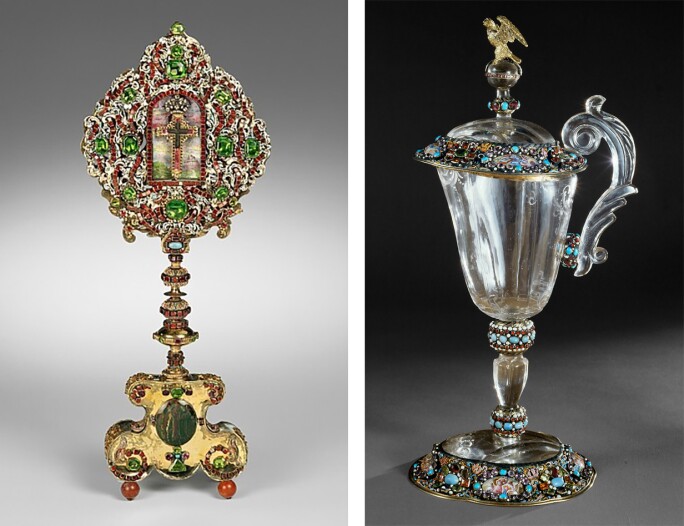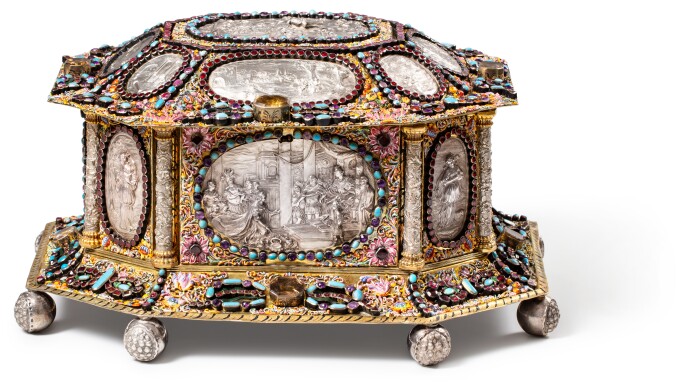Hans Jakob Mair, a Celebrated Goldsmith in his Time
Hans Jakob Mair registered his hallmark in Augsburg in 1641 and played an influential role in the guild, serving as a council member from 1679 to 1682 and then as director from 1684 to 1686. His production is varied, encompassing large presentation dishes characteristic of Augsburg, with contoured rims and centres embossed with mythological or ancient scenes, as well as tankards and cups. He is best known for his pieces combining silver, gilt silver, hardstones, and colored enamels. During the Renaissance and throughout the 17th century, princes and wealthy collectors created cabinets of curiosities, displaying objects made of diverse, exotic materials or in original shapes. Silver-gilt pieces may thus be paired with nautiluses, turbo shells, coconuts, or ivory. Mair specialised in caskets with hardstone plaques, such as jasper, rock crystal, or, in our case, bloodstone. The mounts are in silver-gilt, decorated with extensive coloured enamel decoration. These objects were not intended for practical use but rather to display the wealth and taste of their owner. Mair’s creations are renowned throughout Europe and can be found in various museums today.
In 1675, he delivered a rock crystal, gold, turquoise, and enamel ewer to Leopold I, Emperor of the Holy Roman Empire, who gave it to Tsar Alexis Mikhailovich (Kremlin Museum, inv. M3-1270).
Similarly, a monstrance decorated with blue and red enamels, dated to 1668, is preserved at the Kunsthistorisches Museum in Vienna, alongside a rock crystal ewer (inv. 2369) and a table clock, circa 1665–1669 (inv. 1119). Each piece showcases his signature enamel work in white, red, green, and blue, with leafy scrolls and flowers.

RIGHT : Ornamental Basin with Ewer, Hans Jakob Mair, Augsburg, c. 1685/87, Kunsthistorisches Museum, Kunstkammer Wien Room XX, inv. Kunstkammer, 2369 © Kunsthistorisches Museum Wien
A magnificent gilt silver, rock crystal, and enamel casket, dated to 1663, was sold at Sotheby’s Paris, Hôtel Lambert, Une Collection Princière, vol. II, Kunstkammer, October 12, 2023, lot 273. It came from the collections of the German branch of the Rothschild family, whose members sought to recreate cabinets of curiosities in their homes, amassing the finest Renaissance pieces and recognizing the quality of Mair’s work.

The Art of Enamel, a Princely Taste
The combination of precious materials and enamel dates back to the Middle Ages, notably with the technique of enamel on gold, a Parisian speciality around 1400. It is not until the mid-17th century that the most imposing, astonishing, and fantastical pieces, paired with hardstones, are created. Thus, cups made of various stones (agate, jasper, amber, lapis, sardonyx, rock crystal, etc.), from ancient or contemporary times, are paired with mounts in silver, silver-gilt, or gold, enhanced with painted enamels. This technique became a speciality of several cities, such as Milan and Prague with the Miseroni workshops, and Paris. Cardinal Mazarin and King Louis XIV assembled exceptional collections, now preserved at the Louvre Museum.
In Germany, the centres of Nuremberg and Augsburg drew inspiration from French pieces and the Miseroni workshops to create objects appealing to the various princes of German cities. Mair crafted a magnificent casket with a simple use of blood jasper plaques, contrasted by an exuberant decoration of flowers and scrolling foliage in various colors. The most striking feature is undoubtedly the finial in the form of Cronos holding a child in his left arm, rendered realistically with various colored enamels.
It is all the more significant because this finial is crafted in gold with the application of enamels using the 15th-century Parisian technique. This technique is renowned as the most challenging to produce due to the differences in temperature and the high costs involved. Mair is thus an exceptional goldsmith who may have found inspiration by admiring the Golden Horse, one of the finest pieces of gold enameled work, preserved at the Collegiate Church of Saint Philip and Saint James in Altötting, near Munich, attributed to a Parisian workshop. A gift from Queen Isabeau of Bavaria to her husband, King Charles VI of France, in 1405, this piece was pawned by the king to his brother-in-law, Duke Louis of Bavaria, and has been in Bavaria since that time.
The depiction of this mythological figure is not coincidental. Cronos, the master of the gods, following an oracle, devours all his male children to avoid losing his power but is ultimately killed by his son Zeus. This image reflects the symbolism of the fragility of power, suggesting that one should not seek to preserve it at all costs. A true humanist prince must remain an enlightened, open, and curious man, rather than a mere despot.